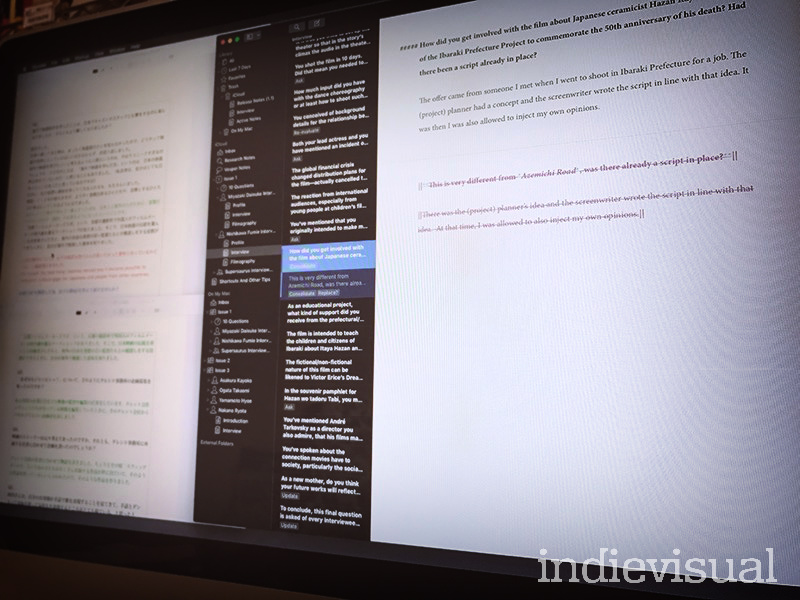After all the planning, researching, note taking, question writing, and translating those to Japanese for the subject to answer, the most labor intensive phase of the entire interview process begins. If the efforts of the previous phases were in service of communicating clearly with the interviewee, these final labors entirely revolve around communicating what the filmmakers express to the reader. Therefore, it is most likely the most important aspect of creating the completed interviews. Conceptually it’s straightforward enough: translate the Japanese answers to English, write out the questions and answers, then edit and refine until they’re ready for publication, but as someone once said, “therein lies the rub.” If anything were that straightforward, these “process” posts wouldn’t be necessary. As it stands, there are some specific and interesting facets to the aforementioned steps.
Translation
The most common way of conducting an interview is to meet the subject and ask them questions directly while recording their responses either on audio or, as is more popular these days, on video….
(Paper, Pen, Keyboard – part 3 cont.)
Upon consulting with filmmaker friends, however, I chose to send out questionnaires to bypass a few issues. Recording an interview would neccesitate transcribing the audio to text. In the case of a foreign language interview, that would mean first transcribing the Japanese prior to actually translating it to English. Of course, I could choose to translate while listening to the audio (i.e. on-the-fly interpreting), but there are two inherent problems which arise as a result. First, issues with audio quality, people’s diction or accents, the speed at which they speak, and my own language level create opportunities to mishear the interviewee. Additionally, just as English contains similar sounding words with different meanings (“carrot and carat”) Japanese have similar sounding words which can are differentiated by their Chinese characters (“kanji”). Confirming these homophones or indecipherable audio will require multiple replays of the recording which adds time to the process. Time, as I’ve noted before, is a commodity in short order and further time consuming steps have to be avoided. With a questionnaire, there’s no guesswork. The kanji is written there; the sentence structure can be seen and broken down; words, proper names, titles, etc. can be copied and researched online; the immediacy of written text hurdles most if not all the challenges associated with transcribing. Sending out questionnaires also alleviates the need to schedule a time and place to meet with a filmmaker to conduct the interview. Many are working directors, if not on their own movies, then on other projects. Attempting to coordinate with their busy schedules would be challenging. A questionnaire can be answered whenever they have free time; and in the case of a couple of interviewees, responses sent back in sections for me to work on as they complete them.
The questionnaire is not without its disadvantages. By not being present to personally react and follow-up with additional questions, I surrender a conversational feel to the interview. Follow-up questions are essential to clarifying somewhat vague or complex responses though I do attempt to solve this in the editing phase which I’ll touch upon later. And even though a questionnaire usually prevents the subject from rambling or going on a different tangent, the filmmaker can still express themselves through allegory or figurative speech which do get lost in the translation. It then falls upon the writing to properly express their thoughts in as comprehensible a manner as possible.
Writing
No matter how impenetrable the metaphor or untranslatable the expression, I can not write whatever I feel is a passable equivalent. Unlike a column or essay, which are my own thoughts and words, there is a requisite responsiblity to the interviewee to not misrepresent them. This might sound obvious, even fundamental, but in the “click-bait” obsessed temperment of today’s internet, it seems less of an obligation and more of an option; at least to this writer. However, since most of the interviewees Indievisual intends to feature will not have been interviewed in English before–at least not at length–the impression left with the reader must be as truthful and unfiltered as possible. However, this does not constitute a strict adherance to the Japanese text which, if translated as written, often results in awkwardly phrased and confusing sentences that violate basics of English grammar. Some judicious rephrasing or “creative license” is ultimately required to produce text which communicates fluently with native English speakers. Striving for this balance between fidelity to the original Japanese source and comprehensibility for the the English reader takes effort, but if the result is an intelligible conveyance of ideas and opinions from speaker to reader, then the effort is certainly not wasted. In fact, this is one of the many exciting writing challenges of creating Indievisual.
In a televised seminar of sorts with Twilight Zone creator and writer, Rod Serling, called “Writing For Television,” there is a segment in which the discussion turns to infusing a personal philosophy into one’s work, and Serling denotes how the characters he writes unintentionally skew toward sounding like himself. Aside from accuracy and understandability, avoiding text which reads as I might speak or write is a hazard of which I must always be mindful. Stylistically, this blog and the accompanying text of an interview can certainly be in my “voice,” but it is another matter to interject the same style into the actual responses from the interviewee. In fact, my earliest attempts at translating and writing responses were suffuse with an academic air as if I were writing a dissertation. I have since attempted to “relax” more and write in a casual, but not informal, tone; allowing for contractions (can’t, don’t, etc.) or mild slang. Few people speak like a university thesis and this should be reflected in how interviewees are represented; finding just the right word or phrase is the key.

Original Japanese and translated interview text being edited.
Editing
The process of editing interviews is not unlike editing a movie. The purpose is similar: to trim excess and minimize confusion. And just like in filmmaking, I also use the process of “pick-ups” to help flesh out the interview or fill in gaps in information. I may want to confirm points I could not translate with confidence or I have the interviewee elaborate on a matter which, when translated to English, required more in the way of grammatical structure though could be implicity understood to a degree in Japanese. Again, in attempt to avoid “putting words in their mouth,” I will give them the opportunity to shed more light on what they intended to say. In other words, this is the time I ask “follow-up” questions.
At this stage also, questions may be merged to solve either one of two specific issues. The first is to eliminate redundancy. For one reason or another–mostly unintended–questions on a similar topic or movie will thematically overlap. The second is to make room for supplemental or replacement questions. As editing progresses, a question or two may be eliminated due to either a problem with the question I wrote, or with the response which can not be resolved. Therefore, a replacement resurrected from the questions eliminated previously in Step 2 will take its place. Likewise, a new question will supplement a response requiring further inquiry, and in some instances, to address a new movie which had not yet been released or been publicly announced while conducting my research. Once I receive the replies to these, I’ll incorporate them into the main text and perhaps rearrange the question ordering to better reflect the altered shape of the interview. Otherwise, the remaining editorial tasks are chiseling away at the text, continually cutting superfluous passages, expunging my poor writing habits, and rigorously searching for the right or better word. I’m not one to insist on perfection, but I do believe striving for it is essential so long as the schedule allows.
Like any beginning filmmaker, I held a naiive notion of conducting an interview through a single pass at a questionnaire, first by myself then the interviewee, but in reality this, too, requires a “post-production” phase that is as important, if not more, than the main interview itself. The work isn’t over, however, as there is an introduction to write, filmmographies to compile, and still photographs to procure from the filmmaker, but over the three parts of this series, I hope I’ve given some insight into the particular processes involved in creating the interviews at the heart of Indievisual the magazine and its mission.
